Best
Overall Tuning Accessory
-
Overall: Perfect for both indoor and outdoor performances
-
Best Feature: Swift Tuning Processor
-
TedScore™: 9/10
Best
Budget Tuning Accessory
-
Overall: Tuning Range B0 - B7; A440 Calibration
-
Best Feature: Built-In Vibration Sensor Effectively Handles Noisy Surroundings
-
TedScore™: 8/10
Best
Value Tuning Accessory
-
Overall: Stable and precise tuning for 5 or 6 string bass guitars
-
Best Feature: Detection Range: 27.5Hz-4186Hz
-
TedScore™: 9/10
Ensuring an acoustic guitar is in perfect tune matters a lot—it makes melodies sound sweet as a summer’s day breeze! Discover a simple way to keep your guitar sounding fabulous each time you strum. Dive into this guide where you’ll find a treasure trove of tuning tips that transform this task into a doddle. Brace yourself for an enchanting journey where tuning an acoustic guitar becomes a piece of cake. Curious to know more? Keep reading to unlock the secrets that will make tuning as easy as pie and unleash a whole world of mesmerising music.
Whether you’re a beginner or an experienced player looking to refine your skills, learning to tune your guitar quickly and accurately is a game-changer. From using digital tuners and tuning apps to tuning by ear or harmonics, I’ll cover all the bases.
Trust me, tuning will become second nature once you get the hang of it. Stick with me, and you’ll impress everyone with your perfectly tuned instrument in no time!
The Acoustic Guitar Strings
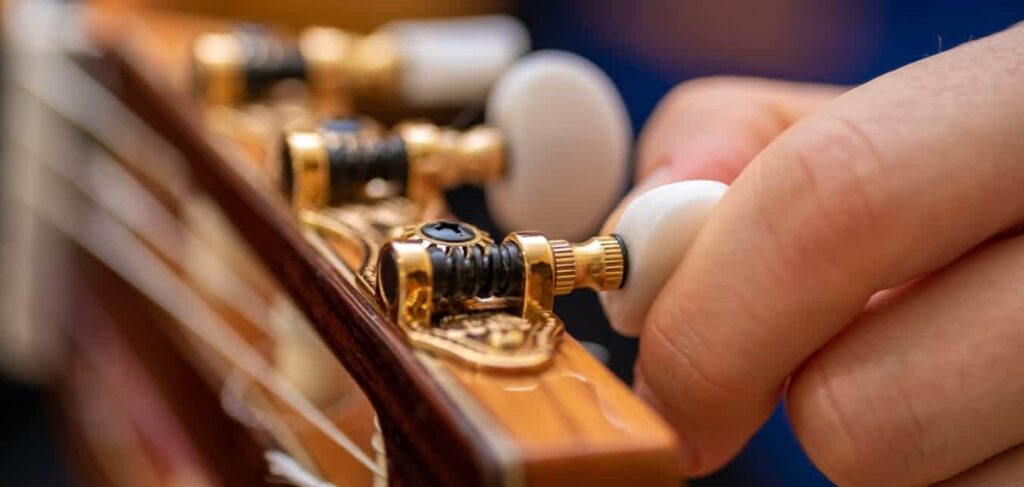
When it comes to tuning your guitar, the strings are your starting point. There are six strings on an acoustic guitar, and they’re usually identified by the note they produce when played open (without being fretted).
Each guitar string is named by its note: the low E string (the thickest string), A, D, G, B, and high E (the thinnest one).
Understanding
Standard Tuning
When your guitar has been tuned to standard tuning– the most common way of tuning an acoustic guitar – each open string should produce a certain note.
Starting with the low E string and moving up, the standard guitar tuning is EADGBE.
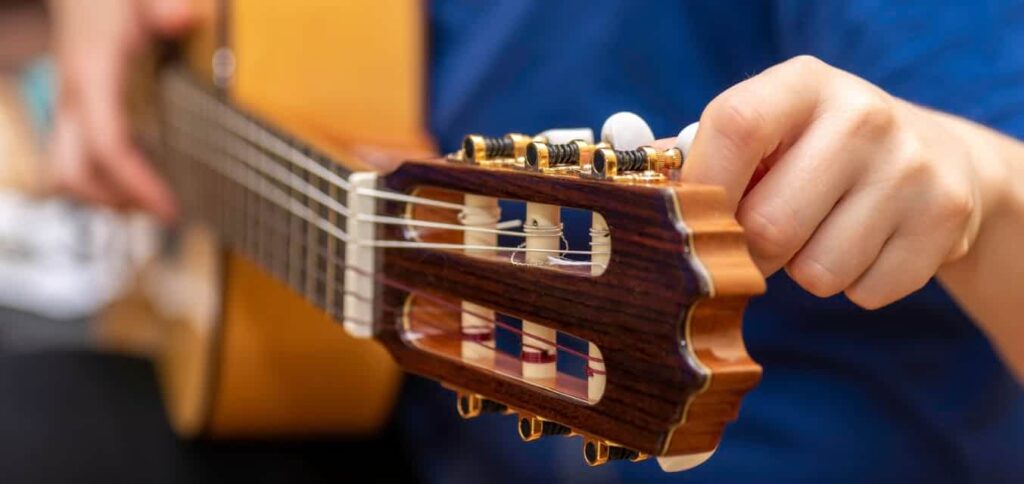
When adjusting the tuning pegs on your guitar, remember that turning each peg in a clockwise direction will make the string tighter and cause the pitch of the note to increase. Conversely, turning each peg counter-clockwise will make the string looser and lower its pitch.
It’s always best to tune up the strings to reach the desired pitch rather than down. If a note is too sharp, you should loosen it past the required pitch until it becomes flat and then tune up slowly from there.
Doing this can help ensure that your strings remain in tune since the gears inside of each tuning peg are less likely to move or become loose after tuning up.
Alternate Tunings for Acoustic Guitar
While standard tuning is great, there are many other tunings to experiment with, which can create new sounds and inspire creativity. Alternate tunings can be used to play different chords, create interesting harmonies, and explore new genres of music.
Drop D Tuning
One of the most popular alternate tunings is Drop D tuning, which is a great way to get a heavier sound.
To do this, you just drop the sixth string (the low E) down to a D note.
This tuning is used in many genres, including hard rock and heavy metal music.

Open D Tuning
Open D tuning is another popular alternate tuning for acoustic guitar. To achieve this, you tune the strings to an open D chord (D-A-D-F♯-A-D). With open D tuning, you can easily create lush-sounding chord progressions as well as complex fingerpicking patterns.
You can also quickly switch between chords without having to retune your guitar due to the intervals between the strings being similar.

Open D tuning is popular amongst folk and blues guitarists as it allows for a wide range of sounds and melodies.
Open G Tuning
Open G tuning drops the low E string to a G note, and then all of the other strings stay in standard tuning.
This means you can play the G chord with just an open strum.
It’s perfect for bluesy slide guitar, giving the player a lot of flexibility in their playing and allowing them to explore different sounds.
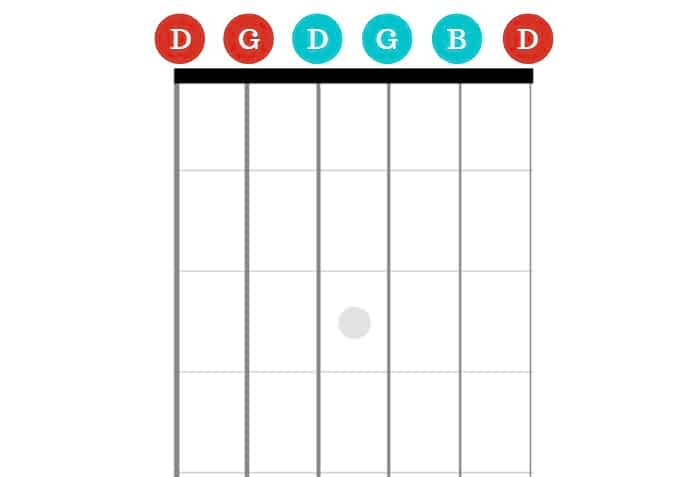
How to Tune Your Acoustic Guitar Using a Tuner
Tuning an acoustic guitar using a tuner is a straightforward process. Here’s a step-by-step guide to help you tune your acoustic guitar accurately:
Place the tuner in a convenient location for easy visibility while playing.
Turn on the tuner and select the acoustic guitar tuning mode.
Pluck the low E string and observe the pitch on the tuner’s display.
Adjust the tuning peg: tighten if the pitch is too low, or loosen if it’s too high.
Continue plucking the low E string and adjusting until the tuner shows the correct pitch.
Repeat steps 3-5 for each string (A, D, G, B, and high E).
Strum lightly to check if all the strings are in harmony with each other.
How to Tune Your Acoustic Guitar Using Harmonics
If you don’t have an electronic tuner, you can still tune your guitar by using harmonics. This technique involves playing a harmonic note on each string and then adjusting the tuning peg until it matches the note of the harmonic.
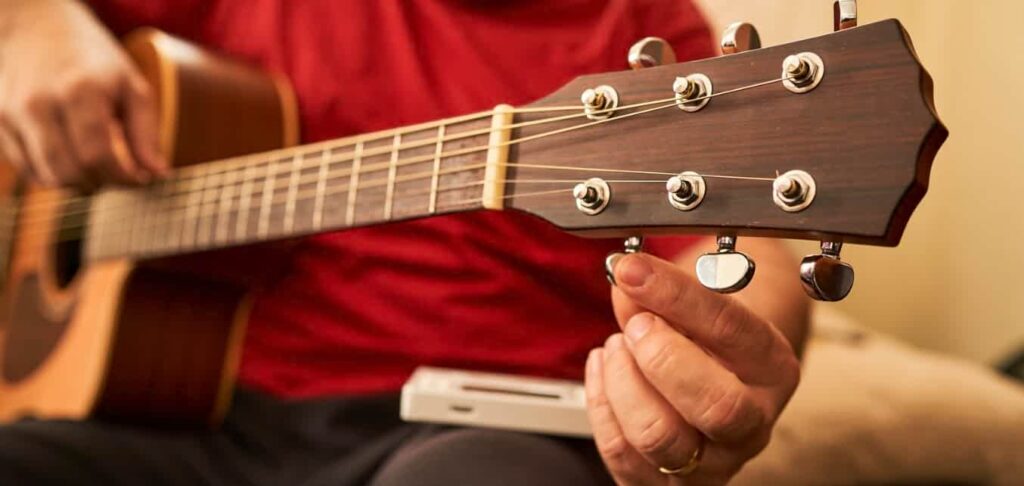
To play a harmonic, lightly touch the string directly above the fret and pick the string. This will create a bell-like sound that is higher in pitch than when you pick normally. Tune each string to its respective harmonic note at the 5th, 7th, or 12th frets.
Once you have tuned the strings, check your tuning against each other by playing chords until they all sound in harmony.
How to Tune Your Acoustic Guitar by Ear

Pick a reference note, such as an A on a piano or pitch pipe.
Find the same note on your guitar with the sixth string at the 5th fret.
Compare this to the open A string and adjust accordingly using your tuning pegs.
Continue this process for each string, with the exception of G. To find your B string, tune the fourth fret of the G string.
If you don’t have access to a reference note, you can use “relative tuning” from one string to another instead. For example, compare the fifth fret of one string to the open string below it, and adjust accordingly.
When you’ve tuned all six strings, play a few chords to ensure you’re in tune.
If necessary, repeat the process until everything sounds good.
How to Tune Your Acoustic Guitar Using an App
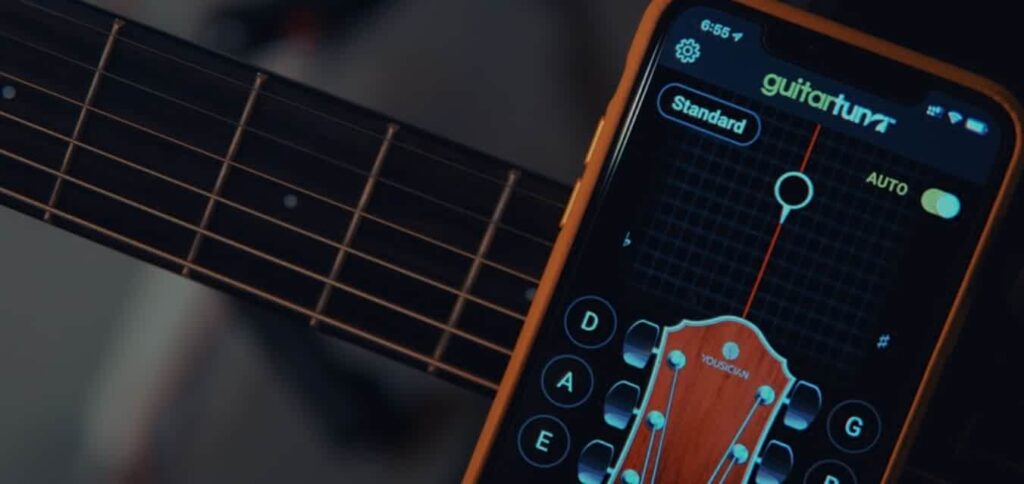
If you have a smartphone, you can download a guitar tuning app. These apps are designed to help you tune your acoustic guitar quickly and accurately by listening to the notes of each string and comparing them to the desired pitch.
Once you have chosen an appropriate app, simply turn on your phone’s microphone, pluck each string, and the app will tell you if your tuning is correct or not.
Recommended Apps for Tuning Acoustic Guitars
Different tuning apps work better for different guitars, but here are a few of the most popular and well-regarded ones:

PERFECT FOR: Players of all levels
FEATURES: Offers over 100 tunings for 15 different instruments
OTHER INFO: Compatibility: Requires iOS 12.0 or later
GuitarTuna: Chords,Tuner,Songs
When you check the price above, you’ll see there are loads of great places to buy this item. Our personal favorite is Gear4music.
It is the largest music retailer in the UK and fast becoming the most respected online music shop in the US too. Their customer service is excellent, they have competitive prices, really fast shipping, and usually have the longest guarantee.
Most professional musicians use Gear4music, so there is no reason why you shouldn’t too!
- Easy to use
- Tons of tunings and songs
- Play-synced scrolling
- Metronome and practice tools.
- Subscription required for unlimited song access.
The professional musician who wrote this article combined many things,
from the product build, manufacturer’s reputation through to feedback
from other users, to create our famous TedScore™.
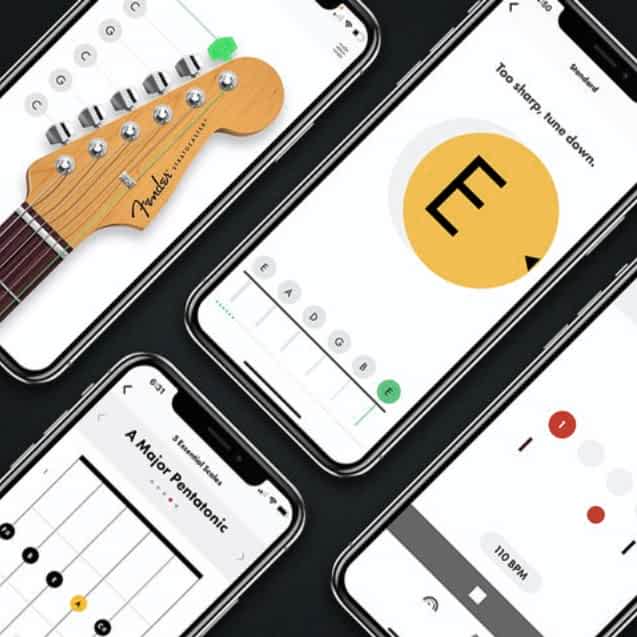
PERFECT FOR: Beginner to Intermediate
FEATURES: Provides access to 5000 interactive guitar chords and 2000 guitar scales
OTHER INFO: Compatibility: Requires iOS 10.0 or later
Fender Guitar Tuner
When you check the price above, you’ll see there are loads of great places to buy this item. Our personal favorite is Gear4music.
It is the largest music retailer in the UK and fast becoming the most respected online music shop in the US too. Their customer service is excellent, they have competitive prices, really fast shipping, and usually have the longest guarantee.
Most professional musicians use Gear4music, so there is no reason why you shouldn’t too!
- Auto, manual, and chromatic tuning modes
- 26 preset tunings and ability to create custom tunings
- Interactive guitar chords and scales
- Metronome and drum tracks
- Precision pro tuner
- Tutorial videos and tuning tips for beginners
- Inaccurate tuning suggestions led to breaking a string.
- Notes drift flat by a quarter step when fading out, causing inaccuracies and confusion.
The professional musician who wrote this article combined many things,
from the product build, manufacturer’s reputation through to feedback
from other users, to create our famous TedScore™.
The Right Tools for Tuning an Acoustic Guitar
A tuner is an essential tool in the musician’s toolkit. It ensures that your guitar sounds great every time you pick it up.
Without a tuner, you could be playing off key and losing out on some of the incredible music your acoustic guitar can produce. Below are some of the best tuners for an acoustic guitar:
Korg Pitchclip 2 Tuner
The Korg Pitch Clip 2 Tuner provides precise and reliable tuning for all instruments in any environment.
With a 140% increase in holding power, rubber grips for protection and an easy-to-read LED display, this device is the perfect companion for guitarists, bassists and ukulele players alike.
The compact design ensures portability and longevity with its 24-hour battery life, while the reverse function makes it ideal for left-handed players or players who want to attach it to the back of their instrument’s headstock.

PERFECT FOR: Beginner to Advance
FEATURES: Detection Range: 27.5Hz-4186Hz
OTHER INFO: Lithium Battery Power Supply
Korg Pitchclip 2 Tuner
When you check the price above, you’ll see there are loads of great places to buy this item. Our personal favorite is Gear4music.
It is the largest music retailer in the UK and fast becoming the most respected online music shop in the US too. Their customer service is excellent, they have competitive prices, really fast shipping, and usually have the longest guarantee.
Most professional musicians use Gear4music, so there is no reason why you shouldn’t too!
- Versatile compatibility with various instruments
- Rubber grips protect your instrument's finish
- Long-lasting battery life with auto-power-off function
- Clear visibility in any lighting conditions
- Stable and precise tuning for 5 or 6 string bass guitars
- None
The professional musician who wrote this article combined many things,
from the product build, manufacturer’s reputation through to feedback
from other users, to create our famous TedScore™.
Snark SN5X Clip-On Tuner
Get in tune with your bandmates quickly and accurately.
This tuner gives you high resolution, quick response, and a backlit color display so you can retune even in the dimmest of venues. One of the best features is that the tuner rotates 360 degrees, making it always viewable and ready to go.
Plus, a long-lasting battery means you can keep tuning for as long as needed.

PERFECT FOR: Beginner to Advance
FEATURES: Swift tuning processor
OTHER INFO: Includes battery
Snark SN5X Clip-On Tuner
When you check the price above, you’ll see there are loads of great places to buy this item. Our personal favorite is Gear4music.
It is the largest music retailer in the UK and fast becoming the most respected online music shop in the US too. Their customer service is excellent, they have competitive prices, really fast shipping, and usually have the longest guarantee.
Most professional musicians use Gear4music, so there is no reason why you shouldn’t too!
- Easy to use design
- Portable and convenient clip-on design
- Perfect for both indoor and outdoor performances
- Suitable for guitar, bass guitar and violin.
- Might be too sensitive for some users
The professional musician who wrote this article combined many things,
from the product build, manufacturer’s reputation through to feedback
from other users, to create our famous TedScore™.
Fender FT-1 Pro Clip-On Tuner, Black
The Fender FT-1 Pro Clip-On Tuner is a fantastic little gadget that packs a powerful punch, ensuring you always sound your absolute best. Whether you find yourself performing on dimly lit stages or amidst a cacophony of noise, this tuner’s got your back.
With its user-friendly LCD display and needle graphic, you can easily read your tuning information with utmost clarity. What sets this tuner apart is its clever dual-hinge design, giving you the freedom to mount it on either side of your headstock.
This way, you can keep it discreet and out of sight if that’s your style.
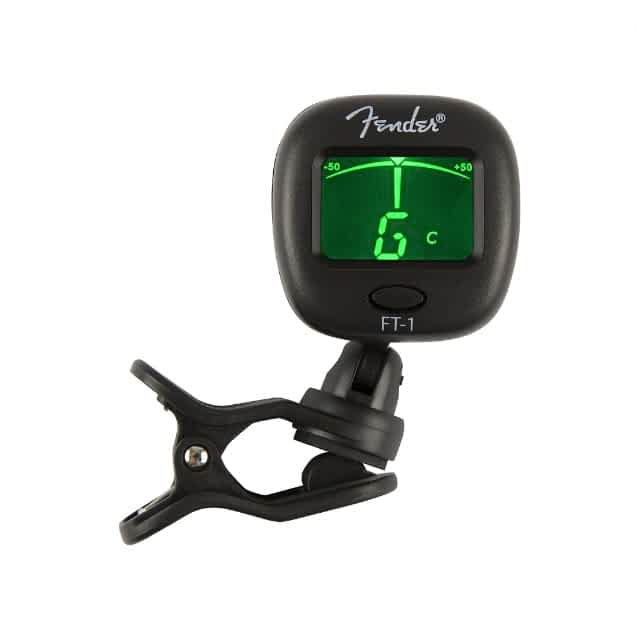
PERFECT FOR: All levels of guitarists, bassists, violinists and ukulele players
FEATURES: Built-in vibration sensor effectively handles noisy surroundings
OTHER INFO: Tuning Range B0 - B7; A440 calibration
Fender FT-1 Pro Clip-On Tuner, Black
When you check the price above, you’ll see there are loads of great places to buy this item. Our personal favorite is Gear4music.
It is the largest music retailer in the UK and fast becoming the most respected online music shop in the US too. Their customer service is excellent, they have competitive prices, really fast shipping, and usually have the longest guarantee.
Most professional musicians use Gear4music, so there is no reason why you shouldn’t too!
- Compact and lightweight for easy portability.
- Easy-to-read display with backlight for low light conditions.
- Highly sensitive vibration sensor
- Supports Guitar, Bass, Ukulele, Violin and Chromatic tuning modes for versatility.
- LCD display is a bit small.
The professional musician who wrote this article combined many things,
from the product build, manufacturer’s reputation through to feedback
from other users, to create our famous TedScore™.
TC Electronic Polytune Clip, Black
Introducing the PolyTune Clip, the innovative and powerful clip-on tuner that revolutionizes the way you tune your instrument. With its three distinct tuning modes, ranging from the polyphonic mode to an ultra-precise strobe tuner mode, this device is designed to deliver superior accuracy and reliability.
Featuring carefully chosen high-quality components, a massive engineering feat and a durable stainless steel clip, the PolyTune Clip is dressed to impress while providing an intuitive tuning experience.
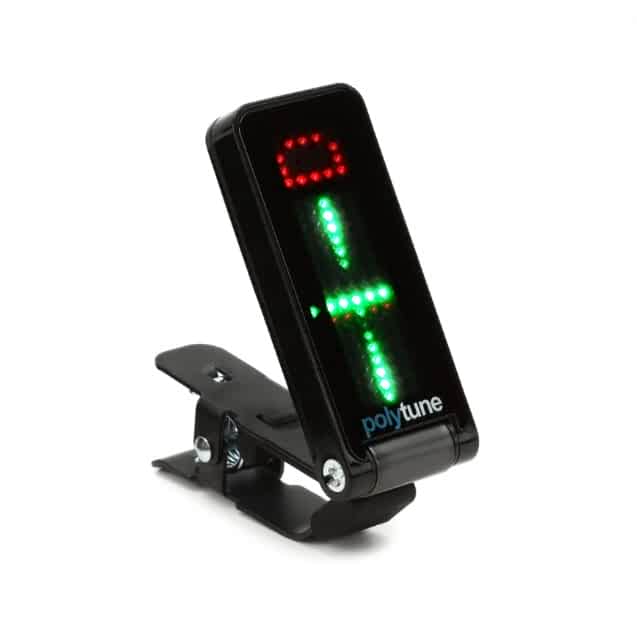
PERFECT FOR: Intermediate To Advance
FEATURES: PolyTune technology allows for simultaneous tuning of all 6 strings
OTHER INFO: Three tuning modes: polyphonic, chromatic, and strobe
TC Electronic Polytune Clip, Black
When you check the price above, you’ll see there are loads of great places to buy this item. Our personal favorite is Gear4music.
It is the largest music retailer in the UK and fast becoming the most respected online music shop in the US too. Their customer service is excellent, they have competitive prices, really fast shipping, and usually have the longest guarantee.
Most professional musicians use Gear4music, so there is no reason why you shouldn’t too!
- Versatile and adaptable design for various playing styles and instruments
- High-quality components and durable stainless steel clip
- Accurate tuning with ±0.02 cents precision in strobe mode
- Flat tuning and capo modes for added flexibility
- No swivel joint for adjustment.
- Prolonged use may potentially harm certain finishes.
The professional musician who wrote this article combined many things,
from the product build, manufacturer’s reputation through to feedback
from other users, to create our famous TedScore™.
D'Addario NS Micro Soundhole Tuner
For those seeking an easy-to-read and accurate way to tune their acoustic guitar, D’Addario’s Soundhole Tuner is the perfect solution.
Its bright, multi-color display provides superior visibility, while its highly sensitive Piezo transducer picks up vibrations of the strings for a fast and precise response.
The other great thing about this tuner is its non-marring clip, which helps ensure a stress-free installation and makes it easy to conceal the device within the soundhole of your guitar.

PERFECT FOR: Beginner to Advance
FEATURES: Non-marring soundhole clip
OTHER INFO: Calibration range: 435-455 Hz
D'Addario NS Micro Soundhole Tuner
When you check the price above, you’ll see there are loads of great places to buy this item. Our personal favorite is Gear4music.
It is the largest music retailer in the UK and fast becoming the most respected online music shop in the US too. Their customer service is excellent, they have competitive prices, really fast shipping, and usually have the longest guarantee.
Most professional musicians use Gear4music, so there is no reason why you shouldn’t too!
- Easy to install and use
- Highly sensitive Piezo Transducer
- Bright and clear LED display
- Precise tuning accuracy
- Battery saves power when not in use.
- Small size may be difficult to see in low light.
The professional musician who wrote this article combined many things,
from the product build, manufacturer’s reputation through to feedback
from other users, to create our famous TedScore™.
Tips and Tricks for Tuning Your Acoustic Guitar

When learning how to play guitar, one of the most important things is making sure your instrument is in tune. It’s easy to overlook this step, but tuning problems can make it difficult or impossible to play accurately.
Pitch Issues
String Buzz
Tuning Stability
Instrument Setup
Environmental Factors
Acoustic Guitar How To Tune
Summary
Tuning acoustic guitar might seem tricky at first, but it gets easier with practice. Remember, the key is patience and consistency.
Here’s a quick recap:
- Use a tuner: Digital tuners, clip-on tuners, and tuning apps like Fender Tune are reliable.
- Tune by ear: Using harmonics or matching pitches requires more practice but is a valuable skill.
- Check string alignment: Ensure the string sits appropriately on the bridge pin and headstock.
- Follow the correct pattern: Start with the thickest string (low E) and up to the thinnest (high E).
Following these steps ensures your guitar sounds great and is ready for any playing session. Keep tuning regularly; you’ll soon develop an ear for the perfect pitch.
Happy playing!
FAQ's
To tune a guitar for beginners, you can use an electronic tuner or a tuning app for convenience. Start by plucking the low E string (the thickest one) and adjust the tuning peg until the pitch matches the desired note.
Repeat this process for the A, D, G, B, and high E strings in that order. You can use reference points like a piano or a reference tone from the tuner to help you achieve the correct pitch.
The proper way to tune a guitar is to ensure each string is in tune with a reference pitch. You can use an electronic tuner, a tuning app, or a pitch pipe to achieve accurate tuning.
Use a standard tuning, such as EADGBE (low to high). If you’re playing with a band or using alternate tunings, make sure you know what tuning everyone else is using.
Standard tuning is the most widely used tuning for acoustic guitars. In this tuning, the strings are adjusted to the pitches E, A, D, G, B, and E, in ascending order. It is commonly employed for various acoustic guitar playing techniques, such as strumming and fingerpicking.
Some electric guitar styles, like blues or jazz, can also utilize standard tuning. Despite the availability of numerous alternative tunings that offer unique sounds, standard tuning remains the preferred option for a large number of guitarists.




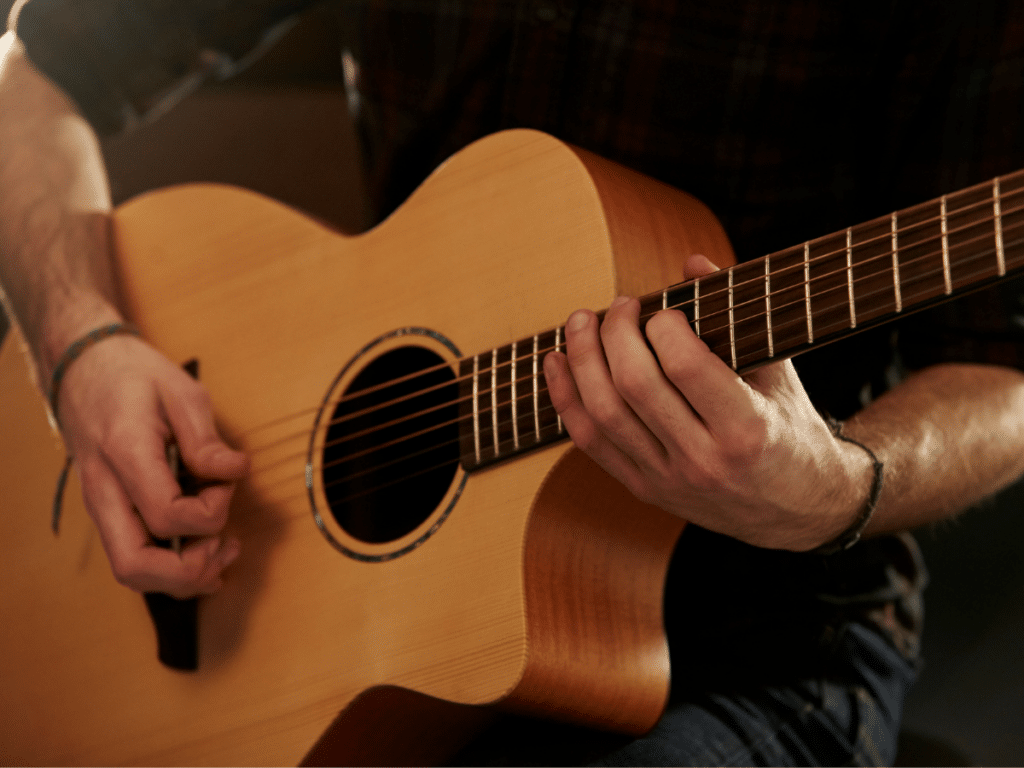








Good breakdown on alternate tunings. I’ve been stuck on standard for too long and this gave me some ideas. Anyone got more tips for transitioning smoothly to something like Open D?
this is super helpful, thnx for posting! was kinda lost about how to start tuning my guitar. Can anyone tell me if it’s better to start with an app or just go straight learning to tune by ear? kinda wanna do it right.
While this is an informative article, I have to say, tuning by ear is an invaluable skill that every guitarist should master before relying heavily on apps and electronic tuners. It’s crucial for developing a good musical ear and understanding your instrument’s unique sound.
Both points are valid. Beginners benefit from apps, while tuning by ear is a skill built over time.
agree to some extent, but apps are super helpful when you’re just starting out.
While the article goes in-depth into several tuning methods, including using an app, I’ve found that tuning by ear, while challenging for beginners, develops a much more intimate understanding of your instrument. Apps are convenient, yes, but nothing beats the ear when it comes to truly knowing your guitar. Plus, depending on a device can leave you stuck when it’s not around. It’s about building your skills from the ground up. Would be interesting to see a follow-up discussion on the pros and cons of each method in more detail. Thoughts, Lewis Turner?
love the tuner app recs, gonna try one rn. my guitar always sounds a bit off lol
Lewis Turner makes valid points about the importance of instrument setup for tuning stability, but it’s crucial to mention that the type of strings and their age also play a significant role. Fresh, high-quality strings are less prone to tuning issues compared to old, worn-out strings. Would love to see a bit more emphasis on this aspect in future articles.
Thx for the tip on strings, Alex! Didn’t know old strings could be such a pain.
Hey Alex, any specific string brands you recommend for a newbie here? Not sure what to go for.
Hey Lewis, great article! Quick q about the Open G tuning – does it affect the guitar neck in the long term? Heard mixed things and don’t wanna mess my acoustic up. Thanks!
In my experience, occasional use of Open G won’t harm your guitar. Just make sure to check the tension and adjust accordingly.
Just finished trying out the open G tuning on my old acoustic after reading your section, and wow, what a resonant and rich sound it produces! Always thought standard tuning was the be-all and end-all, but these alternate tunings add such a unique vibe to the guitar’s sound. Kudos to Lewis for putting together such an informative piece on acoustic tuning. For anyone else reading, don’t shy away from experimenting with your instrument; it’s how you discover its true potential.